Llanfair Caereinion is a town in Montgomeryshire which lies about eight miles west of Welshpool, on the crossroads of the B4385 and the B4389, just south of the main A458 road from Welshpool to Dolgellau. The town has ancient origins, being built upon the site of an old Roman fort, and the site of the Battle of Maes Moydog is nearby. The town developed at an important crossing point on the River Banw and at the crossroads of important routes from the coast to Shrewsbury. The church, which is dedicated to St. Mary, occupies a central position within the town. Outside the boundary wall of the Churchyard adjacent to Broad Street is the town war memorial, which commemorates the men, and one woman, of the town who fell during both World Wars, some 33 during the Great War and a further ten during World War Two. There is also a glazed parchment roll of honour inside the Church which commemorates the 216 people of the town who served during the Great War.
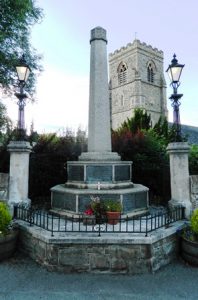
The Great War, 1914-1918
Jonas William Anderson, MC, Major, Royal Army Medical Corps. Jonas was the son of David Clark Anderson and Annie Elizabeth Anderson, of Southport, Lancs. He was educated at Liverpool University where he graduated M.B. and Ch.B. (Vict.) in 1898. After acting as house-surgeon of the Liverpool Royal Infirmary, and of Southport Infirmary, he volunteered to serve with the Royal Army Medical Corps during the Anglo-Boer War and was a surgeon aboard HM Transport Orotava. Upon his return, he went into practice at Llanfair Caereinion, where he resided at Vyrnwy House. Jonas then enlisted into the 4th Battalion, Royal Welsh Fusiliers (Territorials) on 24 March 1906, becoming the battalions Medical Officer. Following the outbreak of war, he mobilised with the 4th RWF and landed at Le Havre with the battalion on 4 November 1914. The battalion then became attached to 3 Brigade, 1st Division, joining the Division at rest billets at Bailleul. Jonas was promoted to Captain eight months later, and was later attached to the 3rd Field Ambulance, RAMC, in the same 1st Division. Jonas served throughout the remainder of the war with the Division, being awarded the Military Cross in the New Year’s Honours List of 1 January 1916, for his gallantry in rescuing wounded men under fire at Loos in September 1915. During the summer of 1916, the Division moved south to take part in the Somme Offensive, and saw especially heavy fighting at the Battle of Bazentin and at Flers-Courcelette. The Division wintered on the Somme and followed the German retreat to the Hindenburg Line in early 1917. It was then briefed for an operation on the Flanders Coast, and moved there during the summer of 1917 to prepare for a possible offensive. In the meantime, the Third Battle of Ypres had bogged down, so the Division was sent to Ypres, taking part in the Second Battle of Passchendaele. Then in November 1917 the Division moved south, taking up positions in the Arras sector and bolstering the line near Flesquières, following the German counterattack at Cambrai. The Division wintered here, with the 3rd Field Ambulance setting up at Ytres. James was then placed in command of the stretcher bearers of the Division and promoted to Major. Some weeks later, the 3rd Field Ambulance moved back to Arras, and on 10 February 1918 James left France to return home on two weeks leave. Upon his return, he found the ambulances under repair, being overhauled, and painted, and the units’ horses on loan, helping to plough fields around the city. Arras began to be heavily shelled by the Germans in the early hours of 21 March 1918, as part of the opening artillery bombardment which preceded the launching of the German Spring offensive soon afterwards, and heavy fighting broke out along the section of the front running south from Croisilles to La Fère. Shelling continued the following day, nonetheless the 3rd Field Ambulance began to prepare to move forwards towards the fighting, whilst under shellfire, to get in touch with the 3rd Guards Brigade, which was near Mercatel, and moved forwards through Ransart and Bellacourt to Bretencourt, before setting up a dressing station to prepare for the inevitable rush of casualties. On 26 March 1918 James was leading his men near La Cauche, when he was mortally wounded by shellfire, dying later that day. The 43-year-old was buried by his men in Bac-Du-Sud British Cemetery, Bailleulval, France.
George Edward Astley, Guardsman, 4046, Welsh Guards. George was the son of Pryce and Annie Astley, of Tanhouse, Llanfair Caereinion. As a young man he worked as a cowman at Graig, Llanfair Caereinion, but then left home to join the London and North Western Railway Police Department, becoming a Detective at Lime Street, Liverpool. Following the outbreak of war George, like many other policemen, enlisted into the newly formed Welsh Guards. The Regiment had been raised by Royal Warrant of 26 February 1915, at White City, before landing at Le Havre on 18 August 1915, becoming attached to 3rd Guards Brigade, Guards Division and saw its first major action during the Battle of Loos, which began on 25 September 1915. George would have joined the 1st Battalion, Welsh Guards at some time in the winter of 1917-18, probably after the Guards had taken part in the heavy fighting which followed the German counterattack at Cambrai on 30 November and saw the Guards Division launch a desperate counterattack, aided by tanks, which stemmed the German onslaught. The Guards wintered near Gouzeaucourt, enjoying some brief rest periods out of the line at Arras, over the coming weeks. On 19 March 1918, the Welsh Guards moved to a rest area at Berneville, to rest and refit. In the early hours of 21 March 1918, the Welshmen could hear artillery fire coming from the front, and soon received news that the Germans had launched a massive offensive along the section of line running south from Croisilles to La Fère. On the following day, the CO went forwards to inspect the ground near Mercatel, prior to the Welsh Guards moving there, and setting up camp. On 24 March, the Welsh Guards moved to Boisleux-St. Marc, before taking up positions in front of Boyelles, where the men awaited the advancing Germans. The battalion came under attack on 25 March, first by artillery, then by German infantry, and saw heavy fighting during the day before being forced to withdraw. The following day was relatively quiet, but on 27 March 1917 the Germans attacked the new line near Boisleux-St. Marc, and heavy fighting again ensued. George was killed in action during the fighting that day. The 26-year-old is buried in Bucquoy Road Cemetery, Ficheux, France.
Oswald Morris Astley, Private, 2628, North Staffordshire Regiment. Oswald was the son of Thomas Astley and Elizabeth Astley, of Einion Villa, Llanfair Caereinion. He had worked as a Butler at the Wynnstay Hotel, Llanfair Caereinion, but had left there to enlist at Stafford into the 6th Battalion, North Staffordshire Regiment at some time prior to the war. The battalion was a Territorial unit, based at Burton-on-Trent and attached to the Staffordshire Brigade, North Midland Division. The Division moved to Luton, then to the Bishops Stortford area before embarking at Southampton aboard the SS Empress Queen on 2 March 1915 and landed at Le Havre the following day. The Division then entrained for Bavinchove, before marching to Ochtezeele, prior to marching via Strazeele and Éstaires, before moving to Bailleul, before taking over a section of the line east of Wulverghem, beginning their first tour in the trenches. Oswald was killed in action during a routine tour in the trenches here on 12 May 1915, on the same day that the Division was re-numbered as the 46th (North Midland) Division. The 29-year-old is buried in R.E. Farm Cemetery, Belgium.
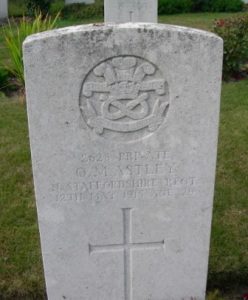
Pryce Astley, Private, 46499, Machine Gun Corps. Pryce was born on 10 January 1897, the son of Joseph and Martha Elizabeth Astley, of Hassall Square, Llanfair Caereinion. He had originally enlisted into the 7th Battalion, Royal Welsh Fusiliers, but was drafted to France and transferred to the 46th Company, Machine Gun Corps, which was attached to the 15th (Scottish) Division. The Company had landed at le Havre on 9 February 1916, joining 46 Brigade of the 15th Division on 11 February 1916, and saw its first major action when the Division was hit by a German gas attack at Hulluch, Loos between 27-29 April 1916, putting up a staunch defence of the Kink position. In July, the Division moved to the Somme, where it took part in the Battle of Pozieres, and then fought at Battle of Flers-Courcelette, where the Division captured Martinpuich. In October, the Division fought at the Battle of Le Transloy, and in the Attacks on the Butte de Warlencourt. By May 1917, the Division was at Arras, and fought at the First Battle of the Scarpe, and then at the Second Battle of the Scarpe, where it captured Guemappe. The Division then moved north to Ypres, where it prepared to take part in the forthcoming Battle of Pilckem Ridge. On the night of 29-30 July, the gun teams of the 46th Company MGC moved into their allotted positions and set up their guns, awaiting zero hour, which was 03.50 on 31 July 1917. At that time, all the guns opened a machine gun barrage onto pre-planned positions, and the Divisional infantry attacked, the machine gunners then lifting their barrage onto the second line, and later onto the third line. Some two hours later, the gun crews moved forwards and set up again, but some hours later the Germans counter-attacked, wiping out at least one gun team. Pryce was wounded at some time during the day and was evacuated to hospital before being sent back to England, and was taken to the Military Hospital at Bagthorpe, Nottinghamshire, where he died of his wounds on 10 August 1917. The remains of the 20-year-old were brought home for burial in St. Mary’s Churchyard, Llanfair Caereinion.
William Pryce Astley, Private, 203413, Royal Welsh Fusiliers. William was the son of Joseph and Elizabeth Astley, of Llanfair Caereinion. William had served with the 5th Battalion, South Wales Borderers and with the Montgomeryshire Yeomanry for several years as a young man, prior to returning to Llanfair Caereinion and becoming a Carpenter. He married Frances Alice Furnival on 1 February 1908, and the couple lived at Tan-y-Fron, Llanfair Caereinion, where they had four children over the coming years. William re-enlisted into the army on 4 December 1915, joining the 7th Battalion, Royal Welsh Fusiliers at Welshpool, and was initially placed on the Army Reserve. He was mobilised on 16 June 1916, joining the 4th (Reserve) Battalion, Royal Welsh Fusiliers at Park Hall Camp, Oswestry. He embarked at Southampton for France on 7 December 1916, and after disembarking at Le Havre joined the 5th Infantry Base Depot at Rouen, before being posted to the 1/4th Battalion, Royal Welsh Fusiliers. The battalion was by then the Pioneer Battalion to the 47th (2nd London) Division, and was at Ypres, based at the Pioneer Camp. Conditions in the camp were harsh, as the Flanders winter was hard, with William joining the battalion in sleet and snow. The men were worked hard, continually on working parties behind the front, repairing roads, constructing, and repairing defences and carrying supplies to the front. During the first week of February the 4th RWF supplied working parties to assist in underground tunnelling at The Bluff, as well as carrying out the construction of a trench tramway and light railway, while two companies worked at Railway Dugouts and Woodcote Farm. William took ill on 24 February and was evacuated to Hospital, being admitted to the 13th Stationary Hospital at Boulogne on 26 February. Sadly, his condition worsened, and he died of pleural effusion on 30 March 1917. The 37-year-old was buried in Boulogne Eastern Cemetery, France.
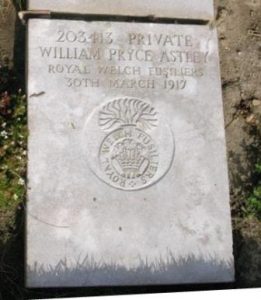
Edward Owen Bourne, Private, 55170, Royal Welsh Fusiliers. Edward was the son of Thomas and Mary Bourne, of The Brickyard, Llanerfyl. He worked for his father at the brickyard prior to the war. Edward enlisted at Welshpool into the Montgomeryshire Yeomanry soon after the outbreak of war. He was subsequently transferred to the Royal Welsh Fusiliers, and after completing his training, landed in France in the winter of 1916-17, joining the 2nd Battalion, Royal Welsh Fusiliers, which was attached to 19 Brigade, 33rd Division. During the coming weeks, the 2nd RWF received several drafts of reinforcements, and on 8 December the now fully rebuilt battalion moved to new positions at Suzanne, between Bapaume and Péronne. The Division remained in this sector over the coming months, before being transferred to the Arras sector, and reached Henin by 13 April, before the Division took over a section of front line facing the Hindenburg Line. The infantry battalions of the division then began the usual routines of rotating between the front-line, support and reserve trenches and the 2nd RWF took over a position known as Tunnel Trench. On 23 April the 2nd RWF took part in a costly assault on the Hindenburg Line, suffering heavy casualties. The battered battalion then moved to a rest camp at Basseux to rebuild, and by 15 May moved back into the line in the Croisilles Sector. The Division then carried out several assaults against the Hindenburg Line, but could not breach it, so on 27 May 1917 a large-scale assault was carried out again, with the 2nd RWF in the thick of the action. The Division remained in the area until the end of June, when it began to withdraw, and by 5 July had reached Airaines, where it spent several weeks resting. On 31 July, the Division entrained for Dunkirk and moved via Bray Dunes before taking over the front line in the Lombardzyde Sector, on the coast. The Allies were intending to launch a coastal assault here once the main offensive at Ypres had broken through, but following the failure of the latter offensive, the 33rd Division was among several transferred to the Ypres Salient, to help bolster the offensive. By 25 September, the Division was in place, and on the following day launched a costly assault on Polygon Wood, suffering heavy casualties. Following a short rest period, the Division moved back into the line, and took part in the final assaults on Passchendaele Ridge. Edward was killed in action near Abraham Heights on 26 November 1917. The 39-year-old is buried in Tyne Cot Cemetery, Belgium.
Evan Ephraim Davies, Private, 202947, Welsh Regiment. Evan was the son of Thomas and Jane Davies, of Neuadd, Llanfair Caereinion. He enlisted into the army at Welshpool and was posted to the 4th (Reserve) Battalion, Welsh Regiment for training. Upon being drafted to France, Evan was posted to the 17th Battalion, Welsh Regiment. The battalion had been formed in the Rhondda Valley, comprised mainly of miners who were under regulation height, becoming attached to 119 Brigade, 40th (Bantam) Division. The Division had moved to France during the first week of June 1916 and moved to the front near Loos. Late in 1916 it moved south to the Somme, and fought at the Battle of the Ancre, remaining in the area over the winter. In March 1917, the Germans withdrew to their shortened line, called the Hindenburg Line, and the 40th Division was one of the Divisions that followed the withdrawal. Later in the year the Division took part in the Battle of Cambrai and launched an attack on Bourlon Wood on 23 November 1917. The attack was carried out by 119 Brigade, led by the 12th SWB and 19th RWF. The 17th Welsh was in support for the initial assault, but was soon ordered to advance, to support the two attacking battalions. Heavy fighting raged within the wood over the coming days, with the 18th Welsh also being thrown forwards into the fight, and the Division suffered terribly. Evan was killed in action within the wood on 25 November 1917. The 19-year-old has no known grave and is commemorated on the Cambrai Memorial, Louverval, France.
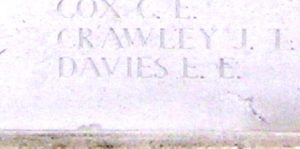
Albert Llewelyn Edwards, Driver, T4/198223, Royal Army Service Corps. Albert was the son of John and Alice Elizabeth Edwards, of 1, High Street, Llanfair Caereinion. He worked as a Saddler and Harness Maker and resided at 28, Bridge Street, Newtown prior to the war. Albert had already served for five years with the Montgomeryshire Yeomanry prior to enlisting into the Army Service Corps on 9 December 1915 and was placed on the Army Reserve. He was mobilised on 31 May 1916 and was posted to the ASC Depot at Woolwich for training as a Driver. Albert had only been at Woolwich for two months before his health began to fail, and on 25 August 1916 he was discharged from the army as medically unfit after being diagnosed as suffering from dementia praecox. Albert returned home, but was then hospitalised at Bicton Heath, where he died on 10 March 1917. The remains of the 27-year-old were brought home, and he was buried in St. Mary’s Churchyard, Llanfair Caereinion on 14 March.
Dora Gray Evans, Nurse, French Red Cross. Dora was the daughter of Edward Anwyl Evans and Annie Angharad Evans, of High Street, Llanfair Caereinion. She worked as a housekeeper for her parents at Commerce House prior to the war, then volunteered to serve as a Nurse with the Red Cross. Dora embarked for the Western Front and served throughout the war with the French Red Cross. Little else is known of Dora, but she died at home on 16 November 1920. The 33-year-old spinster was buried in St. Mary’s Churchyard, Llanfair on 16 November. She is not commemorated by the CWGC.
Richard Evans, Private, 54117, Royal Welsh Fusiliers. Richard was the son of Edward and Ann Evans, of Cefn Crin, Castle Caereinion. He worked as a cowman at Tynllan Farm, Castle Caereinion prior to the war. Richard enlisted into the Royal Welsh Fusiliers at Welshpool, and was drafted to France in the autumn of 1916, joining the 2nd Battalion, Royal Welsh Fusiliers, which was attached to 19 Brigade, 33rd Division. The Division had seen heavy fighting on the Somme during the summer of 1916, and had suffered heavy casualties, especially at Bazentin Ridge and High Wood. The 2nd RWF then spent most of October in reserve, rebuilding at Lucheux, before moving back into the line and moved into trenches at Lesboeufs. The Division spent the winter in the Suzanne area, and at the beginning of April 1917 began to move away from the Somme, taking over positions facing the Hindenburg Line at Croisilles, east of Boiry-Becquerelle. On 23 April, the battalion took part in a costly assault against the Hindenburg Line and when relieved the following night moved to Basseux to rest. On 15 May the battalion moved back into support positions near St. Leger, and on 20 May witnessed another attack by the 33rd Division against the Hindenburg Line, which saw a section of the outer line captured. On 27 May 1917, the battalion was still in reserve positions when it came under shellfire from German artillery. Richard was killed during the barrage that day. The 28-year-old has no known grave and is commemorated on the Arras Memorial, France. His brother, Edward, was killed in France two months later.
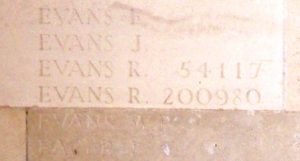
Thomas Evan Evans, Private, 75060, Northumberland Fusiliers. Thomas was the son of Thomas Evan Evans and Jane Elizabeth Evans, of Old Chapel House, Watergate Street, Llanfair Caereinion. He enlisted into the army at sometime late in 1917 and was probably posted to a Training Reserve Battalion. He embarked for France to join the Border Regiment but was instead posted to the 12th/13th Battalion, Northumberland Fusiliers. The battalion had been formed from the amalgamation of the 12th and 13th Battalions of the Northumberland Fusiliers in France on 10 August 1917, and was attached to 62 Brigade, 21st Division at Fontaine-les-Croisilles. The Division was relieved in September, and moved to the Ypres Salient, reaching Westoutre by 29 September, where it received orders to launch an attack in conjunction with the 5th and 7th Divisions near Polygon Wood, launching the attack on 4 October. The Division saw heavy fighting during the day, in attaining its objectives near Reutel. The Division then took part in the attack on Polderhoek Chateau three weeks later, then on 17 November was relieved again, and moved to the Arras Sector, to take part in the great Battle of Cambrai. The division remained in the area over the winter and was one of the units hit by the German Spring Offensive on the Somme on 21 March 1918, seeing heavy fighting as the line was pushed back before being evacuated to Flanders to rest. Unluckily though, the Germans launched a fresh offensive on the Lys on 9 April 1918, and the division was caught up in the thick of the fighting again. The battered division now moved south to rebuild, but again was unlucky, as the Germans launched a fresh offensive on the Chemin-des-Dames, and the division was caught up in the action again, fighting in the Battle of the Aisne, where it suffered terribly again. In June 1918, the Division moved north to the Somme sector, and on 21 August 1918 took part in the great offensive, attacking to the north of the 38th (Welsh) Division, before crossing the Ancre, and began its drive towards the Hindenburg Line. Within four days the Division had passed the Butte de Warlencourt, before moving past Bapaume, and had crossed the Canal du Nord by 6 September. By the end of the month the Hindenburg Line had been broken and the 21st Division had advanced east of Gonnelieu. During the coming days, the Division reached positions near Gouzeaucourt, and on 7 October the 12th/13th Northumberland Fusiliers moved into assembly positions at Beaurevoir, ready to launch an assault on Walincourt the following morning. The men arose from their trenches at 06.00 on 8 October 1918 and assaulted the village, gaining its objective but suffered over 100 casualties in doing so. Thomas had been killed in action during the fighting that day. The 19-year-old is buried in Naves Communal Cemetery Extension, France.
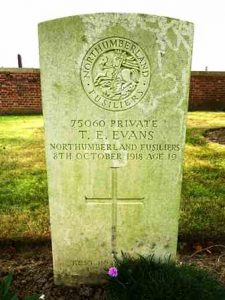
Edward Henry Gittins, Private, 39760, South Wales Borderers. Edward was born at Caersws in 1898. He was raised by his aunt, Elizabeth Watkins, at Soar Chapel House, Llanfair Caereinion. He enlisted into the Royal Welsh Fusiliers at Welshpool, and after completing his training, was drafted to France, joining the 2nd Battalion, South Wales Borderers, which was attached to 87 Brigade, 29th Division. The Division was a vastly experienced one, having seen action throughout the Gallipoli campaign in 1915 before being evacuated to Egypt, and after moving to the Western Front early in 1916 had taken over the line near Beaumont Hamel, taking part in the initial assault of the Battle of the Somme, suffering terrible casualties at Y-Ravine on 1 July 1916. The Division was then pulled out of the line to rest and rebuild before moving back into the line and taking part in the latter stages of the Somme offensive. In the Spring of 1917, the Division fought at the Battle of the Scarpe, which was part of the Arras Offensive, seeing heavy fighting around Monchy-le-Preux, and then moved further north to Ypres, initially to hold the line whilst other units had been withdrawn for specialist training, in readiness for the Third Battle of Ypres, which opened on 31 July 1917. The 29th Division went into reserve whilst the first attacks, the Battle of Pilckem Ridge, took place, then on the night of 14-15 August the 2nd SWB moved into the line facing Langemarck, ready to launch another offensive. On the following day, the battalion reconnoitred the ground in front of them, and laid white tapes in No Man’s Land, to guide the attacking troops, and at dawn on 16 August 1917 the 2nd SWB launched an attack on Langemarck. The battalion successfully took its two objectives but had suffered 163 casualties. The Division then had another period out of the line to rest and refit before taking part in further fighting near Poelcapelle. Early in October 1917 the Division was relieved from the line at Ypres, and moved south to the Bellacourt area, to prepare to take part in the forthcoming Battle of Cambrai. The Division entrained for Péronne on 17 November, marching to a camp four miles out of the town at Haut Allaines, then by midnight on 18 November had reached Fins. On the following day, the Division received its battle stores and detailed orders for the forthcoming battle, marching off via Gouzeaucourt to its assembly positions at Marcoing. The assault began at dawn on 20 November, but the Division suffered terrible casualties whilst attacking Masnières, on the Hindenburg Line. Edward was wounded during the attack, and was evacuated to hospital in Rouen, where he died of his wounds on 30 November 1917. The 19-year-ols is buried in St. Sever Cemetery Extension, Rouen, France.
John Gittins, Private, 91703, Royal Welsh Fusiliers. John was the son of John and Mary Anne Gittins, of Hewarth Farm, Llanfair Caereinion. He worked on his parents’ farm prior to enlisting into the army, and was posted to the 3rd Battalion, Royal Welsh Fusiliers, at Litherland Camp, Liverpool. In November 1917, the battalion moved to Ireland and carried out garrison duties at Limerick until the end of the war. John took ill during the early summer of 1918, after contracting influenza, and was taken to the Military Hospital at Limerick, where he died of influenza on 1 July 1918. The 23-year-old was buried in Limerick (King’s Island) Military Cemetery, Ireland.
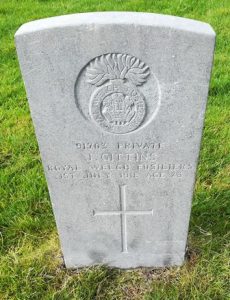
David William Morgan Harris, Private, 54728, Royal Welsh Fusiliers. David was the son of Morgan Jones Harris, and Leah Harris (nee Morgan), of Hendafarn, Llanfair Caereinion. He worked in his father’s carpentry and building business prior to enlisting at Welshpool into the army, and after completing his training, was drafted to France in the summer of 1916, joining the 10th Battalion, Royal Welsh Fusiliers, which was attached to 76 Brigade, 3rd Division. By the middle of June 1916, the Division had moved out of the Ypres Salient to billets around Eperlecques, where intense training was carried out prior to moving to the Somme sector by 2 July. The main Somme offensive had opened on the previous day, and the 3rd Division was ready to enter the fray, bivouacking at Bronfay Farm by 9 July and on 13 July moved into the captured German lines at Montauban Alley. The 10th RWF took part in heavy fighting over the coming days, and on 19 July received orders for an assault on Delville Wood. Just after midnight the following day the battalion moved forwards and became caught in in terrible fighting within the wood, the fighting of such severity that two men of the battalion were awarded the Victoria Cross. On 25 July, the shattered battalion was relieved and moved into reserve and did not move back into the line until 17 August, when the battalion attacked Lonely Trench. On 23 August, the Division moved out of the line to rest and moved to Noeux-les-Mines, near Loos. After a month there, the Division moved back into a rest area for further training before moving back south to the Somme and by 12 November took over trenches at Serre. On the following day, 13 November 1916, the Division launched an assault against the German positions at Serre. The 10th RWF reached Serre village, but the flanking battalions failed to keep up, and heavy losses were suffered, with almost 300 officers and men killed, wounded, or missing. David had been killed in action during the attack on Serre that day. The 34-year-old has no known grave and is commemorated on the Thiepval Memorial, France.
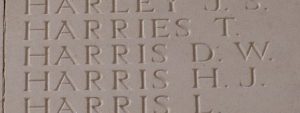
Evan Harris, Private, 11970, South Wales Borderers. Evan was born in Llanfair Caereinion in 1874, the son of Thomas Harris. He had left home as a young man to enlist into the South Wales Borderers on 25 March 1895 and had served in South Africa during the Anglo-Boer War. Evan left the army after his return from South Africa, and on 28 June 1905 married Emma Jane Evans, of Welshpool. The couple then moved to 23, Barrett Street, Cwmpark, Rhondda, where Evan had gained work as a coal hewer. The couple had four children, two sons and two daughters, born prior to the war. Evan re-enlisted into the South Wales Borderers soon after the outbreak of war, and was initially posted to the 3rd Battalion, South Wales Borderers, which was at Pembroke Dock. Evan was drafted out to France early in 1916, joining the 1st Battalion, South Wales Borderers, which was in the Loos Sector attached to 3 Brigade, 1st Division. The Division had suffered heavily during the Battle of Loos from 25 September 1915, and in the subsequent action of the Hohenzollern Redoubt, so Evan would have been among several drafts who arrived as it was rebuilding its strength. By 3 January 1916, the 1st SWB was back in the front line at Loos, beginning a routine tour in the trenches. By now it was the usual routine for infantry battalions to rotate in the trenches, usually spending four days in the front line, four in support and four in reserve, interspersed with carrying out trench raids and carrying parties together with the odd longer spell away from the front, undergoing training schemes. By the middle of May the weather had become hot, and the men of the 1st SWB were put to work making ‘Chevaux de Frise’, or knife-rests as they were known by the British, to install in No Man’s Land during night patrols. On 19 May 1916, the battalion left this work to relieve the 2nd Munster’s in the front line to begin a routine spell in the trenches. As the relief was underway, the Germans opened a ferocious artillery bombardment upon the line, killing Evan and three other men, and wounding several others. Evan was 42 years old when he was killed that day, and is buried in Maroc British Cemetery, Grenay, France. His widow, Emma, returned to her native Welshpool with their four children, but sadly died in 1918, leaving them orphaned.
George Hinsley, Private, 17897, Royal Army Veterinary Corps. George was the son of Thomas and Mary Hinsley, of Dolcelynen, Llanfair Caereinion. He worked as a farm labourer prior to enlisting into the Royal Army Veterinary Corps at Welshpool on 11 December 1915 and was placed on the Army Reserve. He was mobilised on 22 January 1916, but was soon placed back on the Reserve, and was remobilised on 5 July 1916 and posted to the RAVC Depot at Woolwich for training. George began to suffer with his health whilst at Woolwich and was discharged from the army as medically unfit on 28 February 1917, returning home. George died of tuberculosis less than four months later, on 15 June 1917, aged 21. Nothing further is presently known of him, as he is not commemorated by the CWGC.
John Evan Alan Humphreys, Second Lieutenant, Royal Field Artillery. John was the son of Lieutenant Colonel Charles Evan Humphreys and Jane Humphreys, of Mounteinion, Llanfair Caereinion. John’s father was Divisional Sanitary Officer of the Welsh Division, and County Medical Officer for Montgomeryshire. John was educated at Llandovery College from 1912-1916 and is quoted in the 1915 School Journal as being a Prefect and playing at forward for the school XV. He enlisted at Llandovery in 1916 as a Gunner in the Royal Artillery, and was commissioned into the Royal Field Artillery, serving with the ‘C’ Battery (Cardiganshire), 64th Army Field Artillery. John went to the front in June 1916 and the following year he was at Ypres with the battery when the Battle of Third Ypres was launched, its guns set up on the Ypres Ramparts to support the initial attacks. As the line advanced over the coming weeks, John’s Battery moved forwards and set up its guns near Roulers. John was killed in action here by German counter-battery fire on 31 August 1917. The 19-year-old is buried in Brandhoek New Military Cemetery No. 3. His Commanding Officer wrote to his father; “He was a brave, capable and cool-headed lad. His coolness and courage on several trying occasions had given us proof that he would become a most valuable officer. Although he was not with us long, I saw enough of him to realise what a loss we had sustained.”
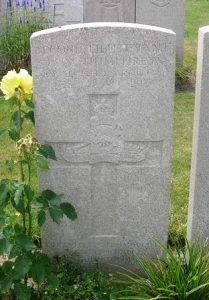
Percy Lloyd Humphreys, Captain, Welsh Regiment. Percy was the son of Cadwallader Humphreys and Sarah Humphreys, of Tylissa, Llanfair Caereinion. He was a manager of the London City and Midland Bank at Llandeilo prior to the war. Percy was one of the original officers of the 15th Battalion, Welsh Regiment, which was raised as part of the Welsh Army Corps by the Carmarthenshire County Committee. The Battalion fought in some of the major actions of the war, attached to 114 Brigade, 38th (Welsh) Division, after landing in France on 4 December 1915. During the winter and spring of 1916, the Battalion held nearly every section of the British line from Givenchy on the La Bassée Canal to Laventie, about six miles South of Armentières. At the end of May 1916, the Battalion moved South with the remainder of the 38th (Welsh) Division to the Somme area, in readiness for the First Battle of The Somme, which commenced on 1 July 1916. The 38th Division were tasked with the taking of the infamous Mametz Wood. The first attack on Mametz Wood was on 7 July, when the division lost heavily in ‘Death Valley’ during the advance on the ‘Hammer Head’. The next attack went in on 10 July, and by 14 July the wood was cleared – but at the cost of over 5,000 casualties in the 38th (Welsh) Division. The battered Division then took over a section of the front at Hébuterne before moving to the Ypres Salient, and taking over the Canal Bank sector at Boesinghe. The infantry battalions of the Division then began carrying out the normal pattern of rotation in the trenches, four days in the front, four in support and four in reserve, whilst also working on trench improvement, digging new trenches, and carrying out regular patrols and trench raids. On 31 July 1917, the Division launched its famous assault on the Pilckem Ridge, capturing Iron Cross and reaching its objective of the Steenbeek. Percy was killed in action during the assault of the 15th Welsh that day. The 35-year-old is buried in Welsh Cemetery (Caesars Nose), near Ypres.
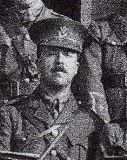
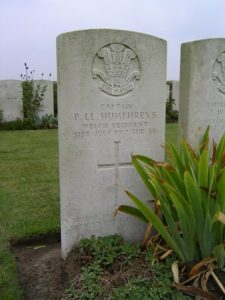
John Ingram, Private, 56818, Royal Welsh Fusiliers. John was the son of Robert Ingram and Ann Ingram (nee Humphreys), of Llyngogr, Llanfair Caereinion. He enlisted into the Welsh Horse Yeomanry at Welshpool soon after the outbreak of war. John did not embark for Gallipoli with the Welsh Horse but must have remained in Norfolk with the 2/1st Welsh Horse, before being drafted to France in the autumn of 1916, and was posted to the 15th Battalion, Royal Welsh Fusiliers. The Division was attached to 113 Brigade, 38th (Welsh) Division, and had suffered a mauling during its capture of Mametz Wood in July 1916. After two days of ferocious hand-to-hand fighting, the wood was cleared up to its northern edge, before the battered Division was relieved. It then took over a section of the front at Hébuterne before moving to the Ypres Salient, and taking over the Canal Bank sector at Boesinghe. The infantry battalions of the Division then began carrying out the normal pattern of rotation in the trenches, four days in the front, four in support and four in reserve, whilst also working on trench improvement, digging new trenches, and carrying out regular patrols and trench raids. On 31 July 1917, the Division launched its famous assault on the Pilckem Ridge, capturing Iron Cross and reaching its objective of the Steenbeek, then played a supporting role in the Battle of Langemarck. The Division was transferred to the Sailly-sur-la-Lys sector in September and remained in the area over the winter. In February 1918, the 15th RWF was disbanded, and John was transferred to the 16th RWF, in the same Brigade. The Division then moved to positions north of Albert, at Bouzincourt Ridge, at the end of March 1918, relieving the battered 2nd and 47th Divisions. It held this sector, again carrying out minor operations and trench raids, over the coming months. On 11 April 1918 the 16th RWF took over the front line in the Bouzincourt Sector for the first time, relieving the 6th Battalion, The Buffs to begin the Divisions first tour in the line here. John was accidentally killed whilst the battalion was being relieved from this tour, on 15 April 1918. The 28-year-old is buried in Contay British Cemetery, Contay, France.
Arthur Lloyd James, Private, 1194, Royal Welsh Fusiliers. Arthur was the son of Edward and Margaret James, of 6, Tanllan, Llanfair Caereinion. He enlisted into the 7th Battalion, Royal Welsh Fusiliers soon after the outbreak of war. The battalion was a Territorial unit, which mobilised for war at Newtown in August 1914, as part of North Wales Brigade, Welsh Division and moved to Conway until the end of the month, before moving to Northampton. In December, the Division moved to Cambridge and then in May 1915 to Bedford, where the Division was numbered and the formation became 158 Brigade, 53rd (Welsh) Division. On 19 July 1915, the entire Division sailed from Devonport for Imbros and on 9 August 1915 landed at Suvla Bay. The infantry moved off the beaches into the bush, but due to a lack of maps and no knowledge of the terrain, many of the units became disorientated, and the situation became chaotic. Arthur was killed in action on the following day, 10 August 1915. The 20-year-old has no known grave and is commemorated on the Helles Memorial, Gallipoli.
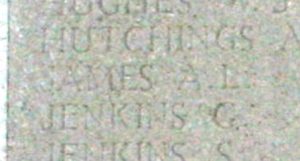
Edward Jarman, Private, M2/116500, Royal Army Service Corps. Edward was born in Atherton, Lancashire in 1887, the son of William and Ann German. His father was originally from Newtown and appears to have altered the family name from German to Jarman prior to returning to his hometown, and resided at 3, Stone Street, Newtown. Edward resided at Rallt Isa, Llanfair Caereinion prior to enlisting into the Army Service Corps, and was posted to the Motor Transport section for training. He was drafted to France on 28 September 1915 and served on the Western Front for the rest of the war, returning home after the Armistice. Edward died, probably of influenza, at Epsom Military Hospital, Surrey on 12 April 1919. The remains of the 32-year-old were brought home for burial in St. David’s Churchyard, Newtown.
David Richard Jehu, Driver, TS/10287, Royal Army Service Corps. David was the son of Edmund and Alice Jehu, of The Hollies, Llangedwyn. He married Mary Ann Davies at Llanfair Caereinion on 24 April 1916, and the couple lived at The Goat Hotel, where David worked as a Wheelwright. He enlisted into the Army Service Corps at Welshpool on 7 December 1915 and was posted to their Depot at Woolwich for training. David embarked for France just four days afterwards, disembarking at Le Havre on 13 December and joined the 6th Auxiliary Horse Transport Company, ASC, before entraining for the Italian front. The British and French had sent several divisions to bolster the Italians on the frontier, following a series of heavy losses, and set up defensive positions along the Piave River. The British withdrew a number of these Divisions following the launching of the German Spring offensive of 21 March 1918, but David remained in Italy with the remaining units. He took ill towards the end of the war, and was evacuated to the 51st Stationary Hospital, where he died of influenza and pneumonia on 29 October 1918. The 35-year-old was buried in Arquata Scrivia Communal Cemetery Extension, Italy.
Percy Ernest Jepson, Private, 35163, Border Regiment. Percy was the illegitimate son of Amy Jepson, of Plas Islyn, Llanfair Caereinion. He enlisted into the 62nd Battalion, Training Reserve at Welshpool on 16 October 1916, and was placed on the Army Reserve. He was mobilised at Wrexham on 17 February 1917 and was posted to Kinmel Park for training. On 4 October 1917 Percy was transferred to the 3rd Battalion, Border Regiment, and on 25 October embarked for France, joining the 7th (Westmorland and Cumberland Yeomanry) Battalion, Border Regiment, which was attached to 51 Brigade, 17th (Northern) Division. Percy was then among several men temporarily attached to the 77th Company, Royal Engineers, to assist on working parties, and on 5 December was awarded the dreaded 28 days Field Punishment No. 1 for failing to comply with an order. The punishment consisted of the convicted man being tied to a fixed object, such as a gun wheel or a fence post, for up to two hours per day, and a loss of pay for the period. Nine days into his punishment, he took ill, and was hospitalised at the 10th Stationary Hospital at Boulogne, before being returned to England aboard the Hospital Ship St. David after his condition worsened and was sent to the 2nd Scottish General Hospital at Edinburgh, where he was treated for chronic nephritis. Percy became more ill, so was discharged from the army as medically unfit on 22 May 1918, returning home to Llanfair Caereinion. He died of his illness on 26 August 1918. The 19-year-old was buried in St. Mary’s Churchyard, Llanfair Caereinion.
Alfred Gronwy Jones, Private, 52034, Cheshire Regiment. Alfred was born at Manafon in 1880, the son of Thomas and Eliza Jones. His parents later lived at Brynglas Hall Farm, Llanfair Caereinion. Alfred worked as a gardener, and lived at Penkridge, Staffordshire by 1911, before moving to Fallowfield, Manchester. He enlisted at Manchester into the Royal Welsh Fusiliers on 23 February 1916, and was posted to Litherland Camp, joining the 3rd Battalion, Royal Welsh Fusiliers. On 4 July 1916 Alfred embarked for France, initially destined for the 1st RWF, but was instead transferred to the 13th Battalion, Cheshire Regiment. The battalion was attached to 74 Brigade, 25th Division and had just taken part in severe fighting around La Boiselle during the opening of the Somme offensive. Alfred joined the battalion at Bus-Les-Artois, where it was resting in billets. The battalion moved back into the Somme front on 31 July, and Alfred would have seen his first action here over the coming days. The Division fought on the Somme over the coming months, before moving to the Ploegsteert sector at the end of October, and held the Ploegsteert Wood sector over the winter, and in June 1917 took part in the Battle of Messines Ridge. The Division then moved to the Bellewaarde Ridge sector and took part in the main Passchendaele offensive from 31 July onwards. At the end of September, the Division moved south to the Annequin sector, near Loos and at the end of December moved to the Arras sector, at Moeuvres. The 13th Cheshire’s was disbanded on 16 February 1918, and on 6 March 1918 Alfred was transferred to the 1/6th Battalion, Cheshire Regiment, which was attached to 118 Brigade, 39th Division. The Division was slightly to the south, holding the Gouzeaucourt sector, and on 21 March 1918 was hit hard when the Germans launched the first phase of their Spring offensive, Operation Michael, along the sector of front running from Croisilles to La Fère. Alfred was reported missing during the coming days and was later found to have been captured by the Germans. He sadly became ill towards the end of the war and died of pneumonia in a German Field Hospital at Le Cateau on 4 October 1918, whilst still a prisoner of war. The 37-year-old is buried in Le Cateau Military Cemetery, France. Alfred is not commemorated on the Llanfair Caereinion war memorial but is commemorated at Manafon.
Arthur Saunders Jones, Second Lieutenant, Royal Air Force. Arthur was born at Llanfair Caereinion on 30 May 1899, the son of Reverend William Jones and Mrs. Mary Ellen Jones (nee Hughes). His father, who was from Betws, Ammanford, died on 12 April 1902, and his widowed mother moved her family to Gorphwysfa, Victoria Road, Prestatyn. He was educated at Christ’s Hospital in Horsham, Sussex. In January 1916, when he was 16 years old, he went to work for the National Provincial Bank of England as an apprentice at its Chester branch. Arthur enlisted into the Royal Flying Corps on 6 June 1917 and was soon commissioned as a Second Lieutenant. He trained as a pilot at Farnborough and Oxford prior to being sent out to France with 108 Squadron, RAF in August 1918. The squadron was a bomber unit, equipped with the Airco DH9 bomber, based at Capelle, near Dunkirk. On 27 September 1918 Arthur took off from Capelle flying DH9, Serial E669, destined to bomb Courtrai and his aircraft never returned. It was later found to have been shot down near Lichtervelde, to the north of Roeselare that day and both Arthur and his gunner, Sergeant Alfred Richardson were buried there in the German Cemetery. After the war, their graves were relocated into Sanctuary Wood Cemetery, Belgium. Arthur was just 18 years old when he was killed that day. His brother, Ivor, had been killed earlier that year. Neither of the brothers are commemorated on the Llanfair Caereinion war memorial.
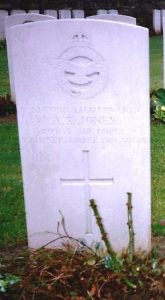
David Frederick Jones, Private, 60748, Welsh Regiment. David was the son of Frederick Jones and Margaret Jones (nee Humphreys), of Tynycoed, Cyfronydd, Castle Caereinion. He worked for the Cambrian Railways prior to enlisting at Wrexham into the Royal Welsh Fusiliers. After completing his training, David was drafted to France, and was transferred to the 14th Battalion, Welsh Regiment, which was attached to 114 Brigade, 38th (Welsh) Division. He probably joined the battalion near Armentieres, where it was rebuilding following heavy losses at Ypres, especially during the assault of the 38th (Welsh) Division on the Pilckem Ridge on 31 July. The Division held a section of front line here until the end of March 1918, when it was transferred south to the Somme sector, to relieve the battered 2nd and 47th Division in the line facing Bouzincourt Ridge, following their withdrawal in front of the German offensive. By 12 April, the 14th Welsh had taken over a section of the Divisional front, and began the usual routine of trench rotation, before being relieved on 19 April, moving into Brigade reserve. David was wounded during this period and was evacuated to the 130th Field Ambulance at Warloy-Baillon, where he died of his wounds on 23 April 1918, aged 19. He is buried in Warloy-Baillon Communal Cemetery Extension, France. He is also commemorated on the Cambrian Railways Memorial, Oswestry.
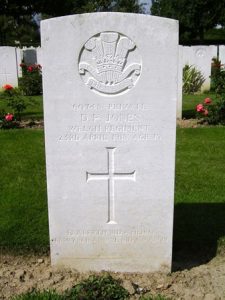
Edward Maldwyn Jones, Private, 37105, Royal Welsh Fusiliers. Edward was the son of David and Jane Elizabeth Jones, of Middle Rhiwhiriaeth, Llanfair Caereinion. He worked as a wheelwright prior to enlisting into the Royal Welsh Fusiliers at Welshpool on 22 November 1915, and was posted to the Depot at Wrexham, before joining the 3rd RWF at Litherland Camp, Liverpool for training. On 26 April 1916 Edward embarked at Southampton aboard the SS Copenhagen for France, joining the 2nd Infantry Base Depot at Rouen. On 7 May 1916 he was posted to the 2nd Battalion, Royal Welsh Fusiliers, which was in Flanders attached to 19 Brigade, 33rd Division. The Division endured a hard time in the line there, holding such notorious sectors as Cambrin and Cuinchy, where underground warfare was prevalent. Soon after Edward joined the 2nd RWF, on 22 June 1916 the Germans exploded a massive mine beneath the position held by B Company, 2nd RWF, which killed 54 men of the battalion, as well as trapping several British tunnellers underground. During the attempted rescue of one tunneller, a soldier of the 14th Welsh, Sapper Hackett was awarded the VC. At the beginning of July, the 33rd Division moved out of the sector and began to move into the Somme area. By 16 July, the 2nd RWF were bivouacked in the newly captured Mametz Wood and moved to Bazentin-le-Petit two days later, to take part in the assault on High Wood. The battalion suffered heavy casualties at High Wood and moved back into reserve at Buire-sur-L’Ancre until 6 August and then spent several days at Becordel before moving back into the line at High Wood on 18 August and helped beat off a German counterattack. Edward was killed in action during the following day, 19 August 1916. The 19-year-old was originally buried on the battlefield, but after the war his grave was located, and his remains were re-interred in Serre Road Cemetery No.2, France.
Evan Ellis Jones, Private, 53975, Welsh Regiment. Evan was the son of David and Mary Jones, of High Street, Temperance House, Llanfair Caereinion. He enlisted into the army in 1915 and was initially posted to the 4th (Reserve) Battalion, Welsh Regiment at Pembroke Dock. After completing his training, he was drafted to France in the summer of 1916, joining the 16th Battalion, Welsh Regiment, which was attached to 115 Brigade, 38th (Welsh) Division. The 16th Welsh had been virtually annihilated during the initial assault on Mametz Wood on 7 July 1916. The Division re-organised before attacking again on 10 July, and after two days of ferocious hand-to-hand fighting, the wood was cleared up to its northern edge, before the battered Division was relieved. It then took over a section of the front at Hébuterne before moving to the Ypres Salient, and taking over the Canal Bank sector at Boesinghe. The infantry battalions of the Division then began carrying out the normal pattern of rotation in the trenches, four days in the front, four in support and four in reserve, whilst also working on trench improvement, digging new trenches, and carrying out regular patrols and trench raids. Evan was at some time attached to the 115th Trench Mortar Battery, which was attached to the same 115 Brigade. The Trench Mortar batteries had been formed in 1916 and were armed with the newly designed Stokes 3” Mortar and were used for both defensive and offensive operations. On 31 July 1917, the Division launched its famous assault on the Pilckem Ridge, capturing Iron Cross and reaching its objective of the Steenbeek. The Trench Mortar Batteries had been kept busy throughout the day, supporting the attack, and by laying down fire on enemy strong points as required. Evan was killed in action during the following day, 1 August 1917. The 24-year-old has no known grave and is commemorated on the Ypres (Menin Gate) Memorial, Belgium.
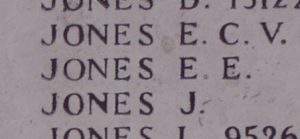
Ivor Dryhurst Jones, Lieutenant, South Wales Borderers. Ivor was born at Llanfair Caereinion on 27 May 1898, the son of Reverend William Jones and Mrs. Mary Ellen Jones (nee Hughes). His father, who was from Betws, Ammanford died on 12 April 1902, and his widowed mother moved her family to Gorphwysfa, Victoria Road, Prestatyn. Ivor enlisted into the Montgomeryshire Yeomanry, but was commissioned into the South Wales Borderers on 28 August 1917. He was posted to the 5th Battalion, South Wales Borderers, which was the Pioneer Battalion to the 19th (Western) Division, joining the battalion at Ypres. The division moved to the Somme following the closure of the Battle of Passchendaele and on 21 March 1918 got caught up in the German Spring Offensive, seeing terrible fighting over the coming days. The battered division was withdrawn and moved to a more peaceful sector near Messines Ridge to rebuild, but on 9 April 1918 the Germans launched a second offensive along the Lys valley and the 19th Division, situated on the Messines to Wytschaete Road, was again caught up in desperate fighting. Two companies of the 5th SWB were sent forwards to take up positions near Lumm Farm on the following morning but found that the divisional infantry had been pushed back, and they were in danger of being surrounded. Ivor was killed during heavy fighting when the battalion was attempting to withdraw to Bois Wytschaete on 10 April 1918. The 18-year-old has no known grave and is commemorated on the Tyne Cot Memorial, Belgium. His brother Arthur was killed just months later. Neither of the brothers are commemorated on the Llanfair Caereinion war memorial. A third, elder, brother, Reverend Willian Alcuin Jones, was an Army chaplain, who was awarded the Military Cross and Bar during the war. The London Gazette of 22 April 1918 published the award of the Bar to his MC and read: ‘For conspicuous gallantry and devotion to duty. During the capture of a hill, he volunteered to take charge of the stretcher bearers and throughout the day attended to and dressed the wounds in the open under heavy machine gun and rifle fire, assisting on several occasions to carry stretchers himself. He displayed marked gallantry and contempt of danger.’ After the war he became Vicar of Llangollen. His son, Ivor Alcuin Jones, served in the RAF in WW2 and died in a flying accident in 1944. He is buried in St John’s Churchyard, Llangollen.
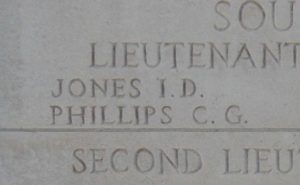
Richard Pryce Pugh, Private, S4/157735, Royal Army Service Corps. Richard was the son of Richard Pugh and Jemima Pugh, of Fron, Llanfair Caereinion. He enlisted into the Army Service Corps and had served on the Western Front until his health began to fail. Richard was evacuated back to England and was hospitalised for a while before being sent to Prees Heath Camp, near Whitchurch. He became ill again whilst stationed there, and was taken to Prees Heath Military Hospital, where he died of acute nephritis on 3 October 1918. The remains of the 22-year-old were buried in Penarth Welsh Congregational Chapelyard, Llanfair Caereinion.
Edwin Rees, Private, 43735, Royal Welsh Fusiliers. Edwin was the son of John Rees and Martha Rees (nee Humphreys, formerly Emberton), of Tyn Llwyn, Llanfair Caereinion. His mother had been widowed twice, her first husband, Noah Emberton, had died in 1884, then her second husband, John Rees, had died around 1900. Edwin had worked as a cowman prior to enlisting into the army, and was posted to the 3rd Battalion, Royal Welsh Fusiliers. He joined the battalion at Litherland Camp, Liverpool, then in November 1917 the battalion moved to Ireland, to carry out garrison duties at Limerick, following the Irish Easter Risings. Edwin must have struggled with his health, as he had returned home to Llanfair early in 1918, and married Jane Roberts in the early summer of 1918. He died at home on 17 November 1918. The 26-year-old was buried in Soar Calvinistic Chapelyard, Llanfair Caereinion. His widow, Jane, later remarried, and moved to 28, Park Street, Bootle, Lancs. Edwin is not commemorated on the Llanfair Caereinion war memorial.
Thomas Evan Richards, Private, 14288, King’s Shropshire Light Infantry. Thomas was the son of Thomas Richards, of Parkyrhiw, Llanfair Caereinion. He worked as a Postman at Bishops Castle prior to the war and enlisted there into the 7th Battalion, King’s Shropshire Light Infantry. The battalion embarked for France on 28 September 1915, attached to 76 Brigade, 25th Division, but two weeks later, 76 Brigade transferred to the 3rd Division, in the Ypres Salient. Arthur did not embark with the battalion at the time but joined among several reinforcements early in 1916. The 3rd Division was holding a sector of the line near Hill 60, which included a feature known as The Bluff. During February and March 1916, a series of fierce actions took place for the Bluff, which afforded a height advantage over the battlefield to the force holding it. The 3rd Division suffered heavy casualties during this period, and then suffered more during the ensuing Actions of the St. Eloi Craters, when the British and Germans fought for control of a series of six craters which had been formed by the blowing of underground mines. The 3rd Division moved south afterwards, to take part in the Somme offensive, the 7th KSLI reaching Carnoy by 7 July. The Division took part in its first major action on the Somme a week later, when it attacked Bazentin Ridge, on 14 July 1916. The 7th KSLI suffered terrible casualties during the assault, with almost 500 officers and men killed or wounded. Thomas was among those killed during the fighting that day. The 37-year-old has no known grave and is commemorated on the Thiepval Memorial, France.
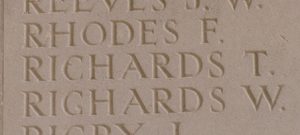
William Vaughan Roberts, Private, 36903, Machine Gun Corps. William was born in Broseley, Shropshire in 1897, the son of PC William Roberts and Elizabeth Agnes Roberts (nee Bowen). His parents were from Llanwyddelan, and his father was a Police Sergeant for the Salop Police, so the family moved around over the years. By 1911 William was living with his aunt and uncle, Richard, and Drusilla Lloyd, at Wainy Bricks, Aberhafesp, and then lived at Bon Marche, Llanfair Caereinion. He enlisted at Welshpool into the 7th Battalion, Royal Welsh Fusiliers soon after the outbreak of war, and trained as a specialist machine-gunner before being transferred to the 9th Company, Machine Gun Corps. The company joined the 3rd Division on 8 February 1916 and saw its first major action during the Actions of the Bluff, and at the St Eloi Craters. The Division was then moved south to the Somme, and fought there at the Battle of Albert, and the Battle of Bazentin Ridge. On 18 August the 3rd Division took part in an attack near Maltzhorn Farm, south-east of Montauban, and on the following day the Division launched an assault on Lonely Trench. William was killed in action whilst supporting the attack on Lonely Trench, on 19 August 1916. The 19-year-old was originally buried on the battlefield on Bazentin Ridge, together with three other men of his company. After the war, their graves were exhumed and re-interred in Flatiron Copse Cemetery, Mametz, France.
Roland Thomas, Private, 55649, Royal Welsh Fusiliers. Roland was born at Pen Capel, Llanerfyl in 1887, the son of John Thomas and Margaret Thomas (nee Richards). After the death of his father, his mother moved to Henefail, Llangadfan. Roland was married to Mary Thomas, of Frongoch, Llanfair Caereinion. Roland enlisted into the Montgomeryshire Yeomanry at Welshpool and was subsequently transferred to the Royal Welsh Fusiliers. He was posted to France early in 1917, joining the 10th Battalion, Royal Welsh Fusiliers, which was attached to 76 Brigade, 3rd Division. In May 1917, the Division was at Arras and fought at the First and Second Battles of the Scarpe, and then at the Battle of Arleux and at the Third Battle of the Scarpe, where the division captured Roeux. On 17 September, after a short rest behind the lines, the Division entrained for Flanders, reaching Gheluvelt the following day. The Division marched through Ypres on 25 September, and crossed the Hannebeek, before taking over a section of the line facing Zonnebeke. At 03.40 on the morning of 26 September 1917, an artillery barrage crashed onto the German lines, then the 3rd Division launched an assault on Zonnebeke, the 10th RWF with orders to follow the initial assault, then advance and take the final objective. As the men crossed the Steenbeek, they lost their bearings, but soon regained their way and reached Zonnebeke relatively unscathed. As soon as the battalion reached the Church, they came under heavy machine-gun fire, and became held up. Roland was killed in action during the fighting near Zonnebeke Church that morning. The 29-year-old has no known grave and is commemorated on the Tyne Cot Memorial, Belgium. His brother, John, was killed in Palestine just weeks later, and is commemorated on the Llanerfyl war memorial.
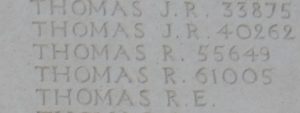
Pryce Williams, Private, 204282, Royal Welsh Fusiliers. Pryce was the son of David and Annie Williams, of Garden Cottage, Pentyrch, Llanfair Caereinion. He worked as a Cowman prior to enlisting into the 4th (Reserve) Battalion, Royal Welsh Fusiliers at Welshpool on 3 February 1916, and was initially placed on the Army Reserve. Pryce was mobilised on 10 April 1917 and was posted to Wrexham, before being sent to Park Hall Camp, Oswestry for training. Pryce embarked at Southampton for France on 3 August 1917, disembarking at Rouen, where he joined the 5th Infantry Base Depot. On 17 August Pryce was posted to the 16th Battalion, Royal Welsh Fusiliers, joining the battalion at Ypres on 25 August. The Division had launched its famous assault on the Pilckem Ridge on 31 July, capturing its objectives, and had taken part in the ensuing Battle of Langemarck. The Division was still at Ypres when Pryce arrived and was hard at work supplying working parties and laying communication cables. The 16th RWF had another spell in the front line at Langemarck from 30 August, being relieved on the night of 4-5 September, and on 10 September packed up their camp, following the transfer of the Division to the Sailly-sur-la-Lys sector, where it remained over the winter before being moved to positions north of Albert, at Bouzincourt Ridge, at the end of March 1918, relieving the battered 2nd and 47th Divisions. The Division held this sector, again carrying out minor operations and trench raids, over the coming months, before taking part in the great offensive of 21 August 1918, and began its advance towards the Hindenburg Line. Over the coming days the Division captured Thiepval Ridge and Pozieres, before clearing Mametz Wood, and capturing Longueval and Delville Wood. By 29 August, the Division had cleared Ginchy and moved into positions facing Morval. The 16th RWF had a brief rest, before taking part in the assault on Morval and Sailly Saillisel on 1 September 1918. Pryce was killed in action during the days fighting. The 22-year-old has no known grave and is commemorated on the Vis-en-Artois Memorial, Haucourt, France.
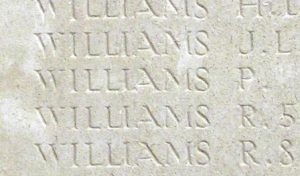
Edward Henry Wood, Private, 202954, Welsh Regiment. Edward was the son of Abraham and Catherine Wood, of Typoeth, Pontrobert. He worked on his parent’s farm prior to the war. Edward enlisted at Welshpool into the army and was posted to the 4th (Reserve) Battalion, Welsh Regiment, which was based in Pembrokeshire. After completing his training, he was posted to the 17th Battalion, Welsh Regiment, which was attached to 119 Brigade, 40th (Bantam) Division. This Division had been formed between September and December 1915 and moved to France during the first week of June 1916, taking over the front near Loos, at Calonne-sur-la-Lys. Late in 1916 the Division moved south to the Somme, and fought at the Battle of the Ancre, remaining in the area over the winter. In March 1917, the Germans withdrew to their shortened line, called the Hindenburg Line, and the 40th Division was one of the Divisions that followed the withdrawal. Later in the year the Division took part in the Battle of Cambrai and launched an attack on Bourlon Wood on 23 November 1917. The attack was carried out by 119 Brigade, led by the 12th SWB and 19th RWF. The 17th Welsh was in support for the initial assault, but was soon ordered to advance, to support the two attacking battalions. Heavy fighting raged within the wood over the coming days, with the 18th Welsh also being thrown forwards into the fight, and the Division suffered terribly. Edward was killed in action within the wood on 25 November 1917. The 25-year-old has no known grave and is commemorated on the Cambrai Memorial, Louverval, France.
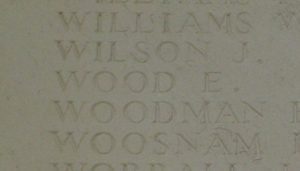
World War Two, 1939-1945
David Oswald Astley, Lance Corporal, 4195021, The Parachute Regiment. David was the son of Joseph Garfield Astley and Mary Astley (nee Roberts), of Llanfair Caereinion. He originally enlisted into the Royal Welch Fusiliers, and was posted to the 10th Battalion, Royal Welch Fusiliers. The battalion was converted to the 6th Battalion, The Parachute Regiment in 1942. The battalion’s first combat action was in 1943, when it participated in an amphibious landing, Operation Slapstick, at the port of Taranto in Italy. The 2nd Parachute Brigade left Bizerta on 8 September, the day before the Italian surrender, and landed unopposed. The only casualties incurred during the operation were fifty-eight men from the 6th Parachute Battalion who drowned after their transport ship HMS Abdiel hit a mine in the harbour. David was unfortunately aboard Abdiel when it sank that day and was drowned. The 27-year-old has no known grave and is commemorated on the Cassino Memorial, Italy.
Denzil Payne Astley, Serjeant, 3974764, The Parachute Regiment. Denzil was the son of Evan Astley and Agness Bella Astley (nee Payne), of Llanfair Caereinion. He originally enlisted into the Royal Welch Fusiliers, and was posted to the 10th Battalion, Royal Welch Fusiliers. The battalion was converted to the 6th Battalion, The Parachute Regiment in 1942. The battalion’s first combat action was in 1943, when it participated in an amphibious landing, Operation Slapstick, at the port of Taranto in Italy. The 2nd Parachute Brigade left Bizerta on 8 September, the day before the Italian surrender, and landed unopposed. The only casualties incurred during the operation were fifty-eight men from the 6th Parachute Battalion who drowned after their transport ship HMS Abdiel hit a mine in the harbour. When the 1st Airborne Division left Italy, the battalion, still with the 2nd Parachute Brigade, remained behind, where it took part in the Battle of Monte Cassino. The battalion’s first combat parachute jump was during Operation Dragoon the Allied invasion of the south of France. After this operation, the battalion returned to Italy, where it was readied for an operation in Greece, Operation Manna, to fill the void left following the withdrawal of the German Army and to ensure that peace was maintained. Unfortunately, Civil War broke out, and the 6th Battalion, which had moved to Thebes, was rushed back to Athens, to hold the Acropolis and strategic junctions. Denzil was killed in Athens on 11 December 1944. The 20-year-old is buried in Phaleron War Cemetery, Greece.
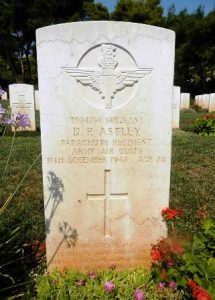
Thomas Herbert Griffiths, Gunner, 1739719, Royal Artillery. Thomas was the son of Ernest David and Martha Griffiths, of Meifod. He married Dorothea Marie James at Birmingham in 1938, and the couple set up home at Llanfair Caereinion. Thomas enlisted into the Royal Artillery, and was posted to the 101st Coast Regiment, RA. Little else is known of the regiment, but Thomas was killed in Italy on 10 August 1945. The 35-yeear-old is buried in Rome War Cemetery, Italy. Thomas is not commemorated on the Llanfair Caereinion war memorial.
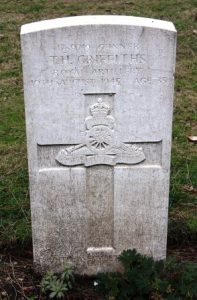
Joseph Emrys Isaac, Private, 11062875, The Buffs (Royal East Kent Regiment). Joseph was the son of Joseph Isaac, and of Mary Ellen Isaac (nee Jones), of Llanfair Caereinion. He enlisted into the army and was posted to the 1st Battalion, The Buffs (Royal East Kent Regiment). The battalion had an interesting war, serving with several different unit, mainly Indian ones, and fought throughout the North African Campaign. The battalion then took part in the Italian campaign, landing at Salerno as part of the 18th Infantry Brigade, and saw heavy fighting during the long slog north through Italy over the coming months. On 1 January 1945, the battalion joined the 24th Guards Brigade, 56th (London) Infantry Division. Joseph was killed in Italy on 3 March 1945. The 24-year-old is buried in Argenta Gap War Cemetery, Italy.
Edward Alcuin Jehu, Sergeant, PLY/X101133, Royal Marines. Edward was born on 19 February 1920, the son of Edward Llewelyn Jehu and Mary Elizabeth Jehu (nee Holloway), of Llanfair Caereinion. He enlisted into the Royal Marines, and underwent the elite Commando Training course, before being posted to No. 48 Royal Marine Commando. The battalion had been formed in March 1944 and was the last commando unit formed during the war, carrying out a shortened commando course at Achnacarry before joining the 4th Special Service Brigade. The Brigade was one of the units assigned to the Normandy landings, and was given the task of seizing several coastal villages, including Luc-sur-Mer, St. Aubin-sur-Mer, and Langrune-sur-Mer, before moving inland to capture the heavily fortified strong point near the radar station at Douvres. Edward landed with the battalion on Juno Beach at dawn on 6 June 1944, near Saint-Aubin-sur-Mer, and started the assault on Langrune-sur-Mer, which was liberated after heavy fighting and severe losses. Edward was killed in action during the assault that day. The 24-year-old is buried in Bayeux War Cemetery, France.
Edward William Jones, Private, 4195061, The Parachute Regiment. Edward was the son of Evan and Elizabeth Jane Jones, of Llanfair Caereinion. He originally enlisted into the Royal Welch Fusiliers, and was posted to the 10th Battalion, Royal Welch Fusiliers. The battalion was converted to the 6th Battalion, The Parachute Regiment in 1942. The battalion’s first combat action was in 1943, when it participated in an amphibious landing, Operation Slapstick, at the port of Taranto in Italy. The 2nd Parachute Brigade left Bizerta on 8 September, the day before the Italian surrender, and landed unopposed. The only casualties incurred during the operation were fifty-eight men from the 6th Parachute Battalion who drowned after their transport ship HMS Abdiel hit a mine in the harbour on 10 September. Edward is shown as having died on 9 September 1943, whilst the Brigade was still at sea. The 23-year-old has no known grave and is commemorated on the Cassino Memorial, Italy.
Charles Leah, Private, 4189181, Cheshire Regiment. Charles was born at Bramhall, Cheshire on 9 July 1911, the son of Walter Leah and Gladys May Leah (nee Evans). His mother was from Llanfair Caereinion, and the family moved back to the town following Charles’ birth. Charles was a regular soldier, having enlisted into the Royal Welch Fusiliers in 1932, and had served in Gibraltar and China. He returned to Britain and left the army, marrying Florence Ivy Wilkinson at Llanfair Caereinion in 1938, and their only child, Jeffrey, was born the following year. Charles re-enlisted soon after the outbreak of war, joining the Cheshire Regiment, and was among several men from the regiment posted to the 113th Company, APMC, embarking for France with the BEF in September 1939, and moving to the Belgian Frontier. Following the German Blitzkrieg, the 113th APMC withdrew towards the Channel Coast, towards Rouen, and set up a defensive line, which was attacked by the Germans on 8 June 1940. Charles was killed during the heavy fighting that day. The 28-year-old is the sole military burial in Grainville-Sur-Ry Churchyard, near Rouen, France.
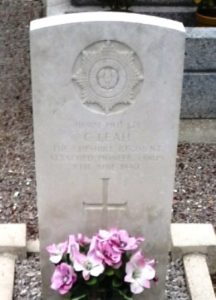
George David Phillips, Fusilier, 5733764, Royal Welch Fusiliers. George was the son of Harry Clement Phillips and Gwenllian Phillips (nee Harris), of Llanfair Caereinion. He enlisted into the 4th Battalion, Royal Welch Fusiliers, a Territorial Army unit, which was attached to 158 Brigade, 53rd (Welsh) Division. The battalion was mobilised at the outbreak of war when the Division moved to Northern Ireland to begin garrison duties. The Division then moved to Pembroke Dock, before moving again to the south of England, where it trained in readiness for the D-Day Landings. On 24 June 1944 the 7th RWF left England for Normandy, and landed at La Riviere near Ver Sur Mer. The Division then took part in heavy fighting over the coming weeks, as part of the effort to break-out of the Normandy beachhead, and saw its first major action during Operation Greenline, the battle to capture the high ground Bougy-Évrecy-Maizet, south of the Odon and some two miles Southwest of the small bridgehead at Baron. For the operation, the 158th Infantry Brigade came under command of the 15th (Scottish) Division, and the 1st Battalion, the Oxford and Buckinghamshire Light Infantry (71st Brigade) were to protect the right flank of the main advance by a subsidiary operation North of the Odon. The Brigade moved into position on 16 July, and launched its assault on the following day, 17 July 1944. George was killed during the attack, in what was a costly day for the Brigade. The 20-year-old is buried in St. Manvieu War Cemetery, Cheux, France.
Edward Christopher Pickmere, Radio Officer, Merchant Navy. Edward was born in Liverpool in 1918, the son of Edward Pickmere, a Merchant Mariner, and Helena Pickmere (nee Carruthers). Following the death of his mother in 1929, his father moved the family to Mount Hall, Llanfair Caereinion. Edward worked as a Postman prior to enlisting into the Merchant Navy and trained as a Radio Officer before being posted aboard the SS Fort Longueuil. She had been launched from the United Shipyards at Montreal and delivered on 8 December 1942 among several ships purchased by the USA War Shipping Administration and leased to the Ministry of War Transport. Fort Longueuil left Barry Docks, in South Wales, on 16 July 1943 with a cargo of Government Stores, including munitions and joined convoy OS52 at Milford Haven. The Convoy set sail for Gibraltar, before steaming to Alexandria, arriving on 8 August, where Fort Longueuil unloaded her cargo, before sailing through the Suez Canal and reached Aden on 8 September. She left Aden the following day, bound for Australia, by now carrying a cargo of 8,475 tons of phosphate. On 19 September 1943, Fort Longueuil was torpedoed and sunk in the Indian Ocean by the German U-Boat, U-532, going down with the loss of 27 of her crew of 59. Edward was 25 years old when he died in the sinking that day, and is commemorated on the Tower Hill Memorial, London.
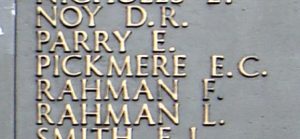
David John Thomas Twist, Flight Sergeant, 1233231, Royal Air Force Volunteer Reserve. David was born in Pewsey, Wiltshire in 1923, the son of Frank Millishamp Twist and Agnes Mary Twist (nee Cottle). The family then came to live at Llanfair Caereinion. David enlisted into the Royal Air Force Volunteer Reserve, and after training as a Flight Engineer was posted to 201 Squadron, Royal Air Force. The Squadron was one of the oldest of the RAF, being originally a Royal Naval Air Service Squadron during the Great War. In 1929 it had become a ‘flying boat’ Squadron, equipped with the Supermarine Southampton, then the Saro London, before being fully equipped with the Short Sunderland in 1940, flying from bases in Pembroke Dock and Northern Ireland. On 14 March 1945 David was one of the twelve crewmembers aboard Sunderland III ML743, which had been despatched on an anti-submarine patrol via the corridor from Castle Archdale to Donegal Bay. Half an hour after take-off, it flew into high ground some five miles north-west of Killybegs, County Donegal, Eire, killing all twelve crew. David’s remains were recovered from the crash site, and the 22-year-old was brought home for burial in Llanfair Caereinion Cemetery, Wales.
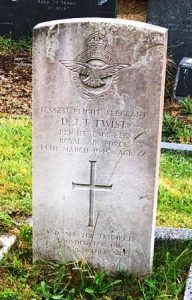
Emrys Williams, Sub-Lieutenant (E), Royal Naval Reserve. Emrys was born in Llanfair Caereinion in about 1904. He went to sea as a young man, and sailed from Liverpool, marrying Muriel Louisa Josephine Hey there in 1938. As an experienced Merchant Mariner, Emrys was granted a commission into the Royal naval Reserve and was posted aboard the ocean boarding vessel HMS Camito. She was an old Elder & Fyffes line cargo steamer, which had been requisitioned in the Great War, to serve as an escort vessel. Returning to Merchant service after the war, Camito was requisitioned again, and was armed with two 6-inch guns and an anti-aircraft gun. On 1 May 1941, Camito was in the North Atlantic, when she was summoned to assist another boarding vessel, HMS Cavina, which had captured an Italian blockade runner, the tanker Sangro, and was ordered to escort the tanker back to Britain. In the early hours of 6 May 1941, Camito was attacked by the German submarine U-97, who fired three torpedoes at her, narrowly missing the steamer. Just over half an hour later, the submarine fired another torpedo which struck Camito, severely damaging her, then sank the tanker. Camito sank soon afterwards, with the loss of 28 lives. Emrys was among those drowned in the sinking. The 37-year-old is commemorated on the Liverpool Naval Memorial, England.